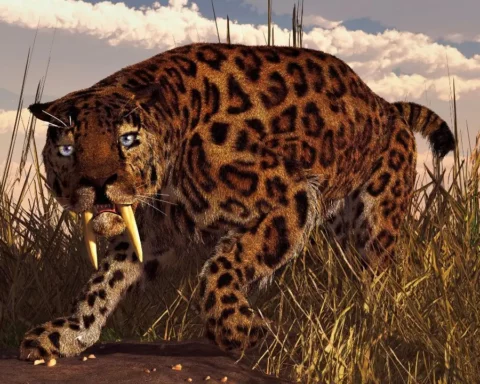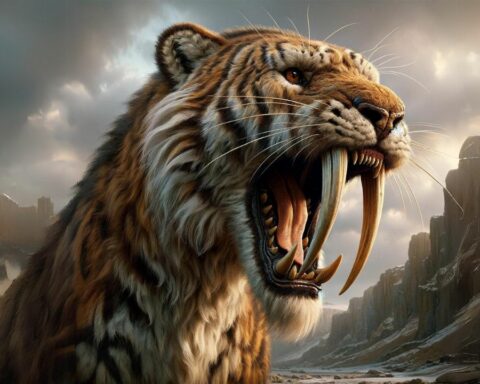Among the extinct animals, the Saber Tooth Cat is very popular and interesting. A Saber Tooth Cat in any extinct member of the cat family that has distinctive pair of long canine teeth that were shaped like a saber (curved sword/ knife). These large teeth remained extended out from the mouth even when the mouth was closed. Here we have gathered complete Saber Tooth Cat Facts that will provide you with all the Saber Tooth Cat Information you need. You are going to learn its definition, scientific name, classification, species, appearance, characteristics, size, length, weight, sound, DNA, skull, bones, teeth, bite, tail, diet, prey, hunting, extinction date & reasons, behavior, adaptations, weakness, predators, history, ancestors, descendants, life cycle, babies, its comparison with various animals and many other interesting & fun facts about Saber Tooth Cat.
Saber Tooth Cat Facts
1. Saber Tooth Cat Description – Saber-tooth Cats Definition
- The Saber-Toothed Cat was a species of the cat family that was one of the prehistoric carnivorous animals that had long, curved teeth.
- These animals became extinct about 10,000 years ago and were mainly found in the Americas.
- Other terms used for it are “saber-toothed lion” and “saber-toothed tiger”, though it is not related to lions or tigers.
- It is now thought to be the fiercest predator that has ever lived and used to be on the top of the food chain during its time.
- Its body was well-developed for hunting, especially its famous canine teeth and muscular limbs.
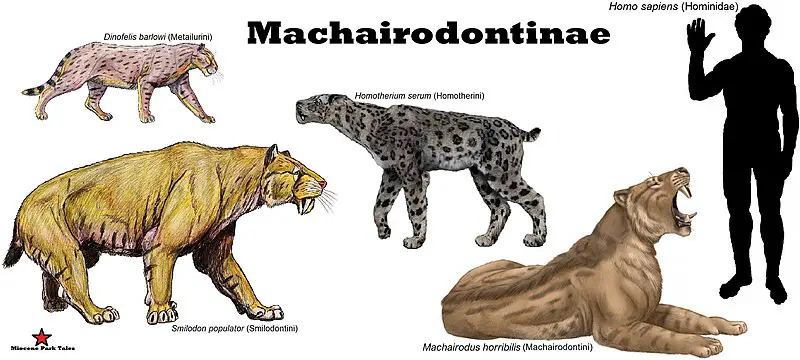
2. Saber Tooth Cat Scientific Name
- There are different scientific names for different species of the saber-toothed cat, and they all belong to the subfamily Machairodontinae.
- This subfamily has four tribes:
- Homotherini
- Machairodontini
- Metailurini
- Smilodontini
- All the genera within this subfamily are
- Amphimachairodus
- Homotherium
- Lokotunjailurus
- Nimravides
- Xenosmilus
- Hemimachairodus
- Machairodus
- Miomachairodus
- Adelphailurus
- Dinofelis
- Metailurus
- Yoshi
- Megantereon
- Paramachairodus
- Promegantereon
- Rhizosmilodon
- Smilodon
3. Saber Tooth Cat Family
- The saber-toothed cat belongs to the subfamily Machairodontinae, which is from the family called the Felidae.
4. Saber Tooth Cat Species
- The saber-toothed cat is from the Machairodontinae subfamily.
- This subfamily has 18 genera, and the 57 species are:
- T. adei
-
- A. alvarezi
-
- A. coloradensis
-
- A. giganteus
-
- A. kabir
-
- A. kurteni
-
- H. ischyrus
-
- H. latidens
-
- H. serum
-
- H. venezuelensis
-
- L. emageritus
-
- L. fanonei
-
- N. catacopsis
-
- N. galiani
-
- N. hibbardi
-
- N. pedionomus
-
- N. thinobates
-
- X. hodsonae
-
- H. zwierzyckii
-
- M. alberdiae
-
- M. aphanistus
-
- M. horriblis
-
- M. laskerivi
-
- M. pseudaeluroides
-
- M. robinsoni
-
- A. kansensis
-
- D. aronoki
-
- D. barlowi
-
- D. cristata
-
- D. darti
-
- D. diastemata
-
- D. paleoonca
-
- D. petteri
-
- D. piveteaui
-
- M. boodon
-
- M. major
-
- M. mongoliensis
-
- M. ultimus
-
- S. teilhardi
-
- Y. garevskii
-
- Y. minor
-
- M. cultridens
-
- M. ekidoit
-
- M. hesperus
-
- M. inexpectatus
-
- M. microta
-
- M. nihowanensis
-
- M. vakhshensis
-
- M. whitei
-
- P. maximiliani
-
- P. orientalis
-
- P. transasiaticus
-
- P. ogygia
-
- R. fiteae
-
- S. fatalis
-
- S. gracilis
-
- S. populator
-
- Other species in the same family are cheetahs, pumas, jaguars, leopards, lions, and tigers.
5. What Did The Saber Tooth Cat Look Like – Saber Tooth Cat Appearance
- The most prominent feature of the saber toothed cat was its set of long, sharp canines.
- It had broad limbs with a short tail, and its feet were smaller compared to other carnivores.
Learn more: What does a Saber Tooth Tiger Look Like
6. Saber Tooth Cat Characteristics
- It was characterized by its short tail, wide limbs, and comparatively small feet.
- Its canine teeth were long, sharp, and curved.
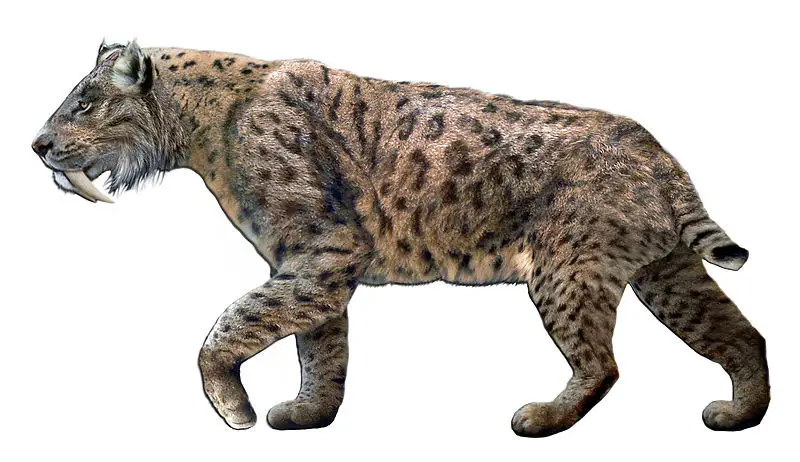
7. Saber Tooth Cat Size – Saber Tooth Cat Size Comparison
- The saber-toothed cat was undoubtedly the largest cat to have lived, but their size varied depending on what species they are.
- The largest saber-toothed cat known was the Machairodus horriblis, which weighed 405 kilograms. It was similar in size to a modern polar bear.
- The smallest saber-toothed cat was undoubtedly the Promegantereon ogygia, weighing only 45-90 kilograms. This was similar in size to a small tiger.
- These carnivores may not have been as large as other animals of its era like woolly mammoths, but surprisingly, they could easily prey on mammoths.
- A lot of them were the same size as fierce cats of today, such as lions, leopards, and jaguars, but they were much larger than the domestic cat.
| Genus | Weight/kilograms | Height/centimeters | Largest Specie |
| Smilodon | 90 | 100 | Smilodon populator |
| Amphimachairodus | 70-130 | 110 | Amphimachairodus giganteus |
| Homotherium | 160-260 | 120 | Homotherium crenatidens |
| Lokotunjailurus | 150 | 90 | Lokotunjailurus emageritus |
| Nimravides | Unknown | Unknown | Unknown |
| Xenosmilus | 180-300 | 110 | Xenosmilus hodsonae |
| Hemimachairodus | Unknown | Unknown | Hemimachairodus zwierzyckii |
| Machairodus | 160-350 | 120 | Machairodus horribilis |
| Miomachairodus | Unknown | Unknown | Unknown |
| Adelphailurus | Unknown | 100 | Adelphailurus kansensis |
| Dinofelis | 50-100 | 90 | Dinofelis piveteaui |
| Metailurus | 50 | 90 | Metailurus major |
| Yoshi | 50 | 70 | Unknown |
| Megantereon | 70-120 | 90 | Unknown |
| Paramachairodus | 30-40 | 60-70 | Paramachairodus orientalis |
| Promegantereon | 45-90 | 60 | Promegantereon ogygia |
| Rhizosmilodon | 75 | 65-75 | Rhizosmilodon fiteae |
Saber-Toothed Cat Height
- If it was as tall as a tiger, its height must have been 70-120 cm.
- If its height was that of a lion, it must have been 1.2 m tall.
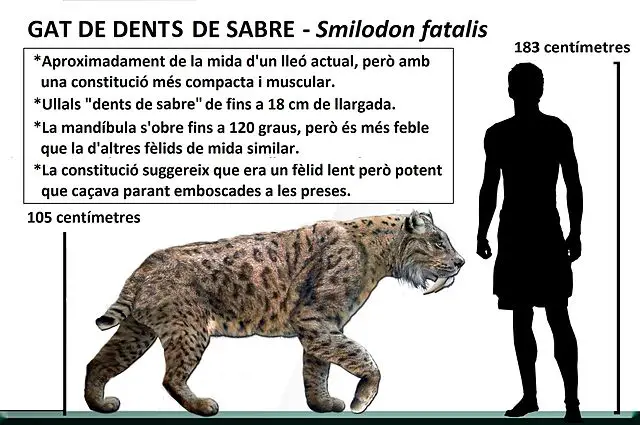
Saber-Toothed Cat Length
- Including the tail, its total body length was 210 cm.
8. How Much Did A Saber Tooth Cat Weigh – Saber Tooth Cat Weight
- Weight varied with different species of the saber-toothed cat, ranging from 55 to 400 kg.
9. Biggest Saber Tooth Cat – Giant Saber Tooth Cat
- Machairodus horribilis is the biggest Saber Tooth Cat with a maximum height of about 120 cm and a maximum weight of up to 405 kg.
10. Saber-Toothed Cat Lifespan – Saber Tooth Cat Lifespan
- The lifespan of the saber-toothed cat is not known.
11. How Fast Can A Saber Tooth Cat Run – Saber-Toothed Cat Speed
- Its maximum running speed is estimated to be 25 to 30 miles per hour.
12. Saber Tooth Cat Sounds – Sabre Tooth Cat Noise – Saber Tooth Cat Roar
- The fossils of saber-toothed cats contain small bones that formed the voice box.
- The arrangement of these small bones and ligaments is similar to that of lions and tigers, which means that they used to roar like a lion.
13. Saber Tooth Cat Fossil – Saber Tooth Cat DNA
- Most fossils of the saber-toothed cat have been discovered in California, the United States of America because this animal used to be very common in this part of North America.
- Tests of DNA samples from their fossils show that the cats of North America and those of Europe were the same.
14. Saber Tooth Cat Skull
- The most prominent feature of the saber-toothed cat’s skull is its set of canine teeth which grew up to 11 inches long.
15. Saber Tooth Cat Bones – Saber Tooth Cat Skeleton
- The saber toothed cat was the biggest and fiercest cat to ever exist, so it had very broad bones.
- The bones of saber toothed kittens were even stronger than the bones of modern-day cats.
- Most skeletons of the saber toothed cat have been excavated from California, the United States of America.
- Some skeletons reveal that it was common for these huge cats to prey on other saber-toothed animals and even hominids.
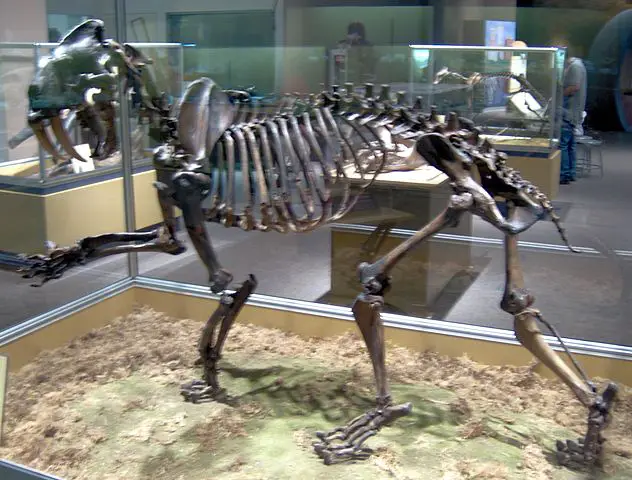
16. Saber Tooth Cat Teeth – Saber Tooth Cats Teeth Size
- The canine teeth in the upper jaw of a saber toothed cat was about 28cm (11 in) long each.
- They could crush the skulls of their prey with their teeth.
17. Saber Tooth Cat Tail
- Compared to other carnivores, the saber toothed cat was known for having a shorter tail.
18. Saber Tooth Cat Bite – Saber Tooth Cat Bite Force
- The bite force of a saber toothed cat was only one-third of the bite force of a modern lion.
- However, its strategy for preying on animals was different. It had very long canines and its mouth could open up twice as much as that of a lion.
19. What Did The Saber Tooth Cat Eat – Saber Tooth Cat Diet
- Its canines were long but rather weak, so while it might have used its teeth for hunting down prey, it is very unlikely that it ate bones. Its diet was mainly comprised of flesh.
- It must have preyed on large herbivores like horses, camels, large pigs, rhinoceros, and young mammoths.
Saber Tooth Cat Prey
- It preyed on mammals with thick skin, such as:
- young mammoths
- rhinoceros
- large pigs
- camels
- horses
Learn more: What did Saber Tooth Tigers Eat
20. Saber Tooth Cat Hunting
- It is likely that the saber toothed cat wrestled down its prey instead of biting into a moving target because its canines could break very easily.
- Instead of directly biting its prey, it used its teeth to stab the victim numerous times to kill it.
21. Where Did Saber Tooth Cat Live – Saber Tooth Cat Habitat
- The saber toothed cat preferred to live in areas with plenty of vegetation, such as woodlands, grasslands, and bushes.
- They inhabit such places because They need vegetation to hide in so that they can ambush their prey.
22. Saber Tooth Cat Range
- Its fossils have been found in all parts of North America and South America.
- Both of these continents fulfilled their requirement of habitat with vegetation.
23. Saber Tooth Cat Map
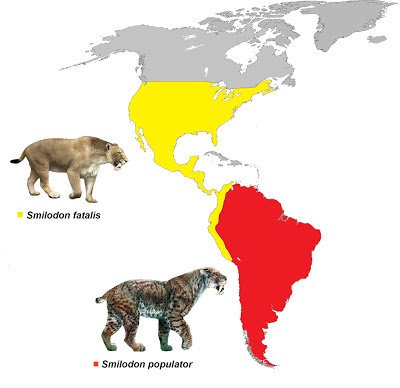
24. How Did Saber Tooth Cat Become Extinct
- The saber-toothed cat eventually got wiped out and became extinct around 12,000 years ago due to several factors which include human activities, lack of prey, and climate change.
25. Why Did Saber Tooth Cat Go Extinct – Saber Tooth Cat Cause Of Extinction – Saber Tooth Cat Extinction Theories
- Some believe that during the last glacial period (called the Quaternary extinction event), the temperature change affected the vegetation and thus the cat’s prey. There were no more herbivores to feed on, so the saber toothed cat died out due to starvation.
- According to another theory, they went extinct around the time when humans were becoming more advanced in hunting technology, so it is possible that humans hunted them down in very large numbers, if not for food, then for safety.
- The temperature also rose a lot during the Quaternary period, and saber-toothed cats were probably affected by it because they were not adapted to such high temperatures.
Learn more: Why did the Saber Tooth Tiger Go Extinct
26. When Did Saber Toothed Cats Go Extinct – Saber Tooth Cat Extinction Date
- Saber-toothed cats went extinct around 12,000 years ago.
27. Saber Tooth Cat Images – Sabre Tooth Cat Pictures

28. Saber Tooth Cat Sightings – Saber Tooth Cat Alive – Saber Tooth Cat Still Alive
- Even though this animal went extinct 12,000 years ago, sightings of the animal are still reported from Europe, Africa, and South America.
- In 1966, a report came from South America from the naturalist Peter Mattheisen, who claimed to have seen a cat the size of a jaguar, with “large protruding teeth”, which are the main characteristic of a saber toothed cat.
- In 1975, another report from Paraguay was by the zoologist Juan Acavar, who supposedly found the carcass of a saber toothed cat that had been shot dead. He immediately recognized it by its large teeth, but he was afraid that if he told people what it was, nobody would believe him. So in the report, he called the animal a “mutant jaguar”.
29. Saber Tooth Cat Behavior
- They are known as vicious and intimidating predators.
- Some skeletons have shown that saber toothed cats often disabled their prey by crushing their skull.
- They most likely ambushed their prey and it to the ground before feeding on it, to protect their teeth.
- They used to live together in groups, just like modern-day lions do.
30. Adaptation Of Saber Tooth Cat – Saber Tooth Cat Adaptations
- The fur of saber toothed cats was many different shades of brown to allow it to bend in many different types of environments.
- Due to its thick fur, short tail, and small ears, it was able to stay warm in the Arctic regions but stay cool in the warm areas.
- Its long teeth and retractable claws helped it hunt down prey efficiently and protect itself from other rivals.
- It had many strong muscles in its body, which helped it run very fast while chasing prey.
31. Sabre Tooth Cat Weakness
- One of the saber toothed cat’s weaknesses was that its long canines were narrow, so they could break very easily.
- It also had weak jaws, so its bite force was not very strong either.
32. Saber Tooth Cats Enemies – Saber Tooth Cat Predators
- The only possible predator of the saber toothed cat were humans, who had become very advanced in hunting and possibly even used to eat the animal.
33. How Did The Saber Tooth Cat Defend Itself
- The cat most likely used its fangs to protect itself from potential danger.
- It also had broad and muscular limbs which it might have used for defense.
- Moreover, it is capable of running at a very high speed.
34. Saber Tooth Cat Evolution – Saber Tooth Cat History
- The saber toothed cat was the most common out of the saber toothed group of predators.
- The structure of the jaw of the earliest saber toothed creatures was the same as that of modern leopards.
- They gradually evolved, their canines growing longer and their body muscles getting stronger.
- They branched out into different species; S. gracilis, S. fatalis, and S. populator.
- These species populated all of North America and South America.
- A study in 2006 proved that the Smilodon was very different from modern-day cats.
- A 2017 study shows that the different species of Smilodon were more diverse from each other than tigers are from house cats.
35. Saber Tooth Cat Ancestor
- The earliest ancestor with saber toothed features was Pseudaelurus, a prehistoric cat.
- The line of descendants from the Pseudaelurus kept evolving, its features changing to adapt to hunting.
- Their canines grew longer, their body muscles became stronger and their limbs shortened, until they became a species we identify as the saber toothed cat.
36. Saber Tooth Cat Descendants – Saber Tooth Cat Closest Relative – Modern Saber Tooth Cat
- Interestingly, the closest living relative of the saber toothed cat is the possum.
- Its canine teeth are very long, relative to its size, and it wrestles its prey to bring it down, just like the saber toothed cat.
37. Saber Tooth Cat And Humans
- The saber toothed cat was likely alive at the time of modern humans.
- One of the theories behind the extinction of the species is that it was hunted down by humans.
38. Where Have Saber Tooth Cats Remains Been Found
- The fossils of saber toothed cats have been found in South America as well as Europe.
- In North America, they are especially common in California, the United States of America.
39. Saber Tooth Cat Africa
- One of the ancestors of the saber toothed cat was Machairodontinae, which were found in North America, South America, Europe, Asia, and Africa.
40. Saber Tooth Cat Europe
- Another fact discovered about saber toothed cats is that they inhabited Europe for 200,000 years.
41. Saber Tooth Cat North America
- Saber toothed cats first emerged in North America and lived there until their extinction because it fulfilled all of their needs.
- The American state of California is where the most fossils of these cats have been unearthed.
42. Saber-tooth Cat In Oregon
- The fossil of the first-ever saber toothed cat from the Ice Age was dug up from Oregon, United States of America.
43. Saber Tooth Cat Nashville
- Paleontologists work at a site called Nashville, which is situated in Davidson County, Tennessee, United States of America.
- There is a cave situated in Nashville which contains the bones of humans as well as those of saber toothed cats.
44. Saber Tooth Cat California
- California contains more saber toothed cat skeletons than any other part of the world.
Saber Tooth Cat La Brea Tar Pits
- La Brea Tar Pits are the part of California where a lot of saber toothed cat fossils have been found.
- These pits of tar existed even millions of years ago.
- Paleontologists believe that these pits trapped large mammals like horses and camels in them.
- Saber toothed cats and other carnivores would also enter the pits, seeing the victims as potential prey, but then get trapped in the tar as well.
- They were unable to get out of the pits, so they died of starvation, decomposed and their bones were preserved in the tar.
45. Saber Tooth Cat And Tiger – Saber Tooth Cat Vs Tiger
- Since saber toothed cats are often called ‘saber toothed tigers’, some assume that they are related to tigers. However, they are not related to tigers in any way.
- Apart from the genetic, difference, they have a lot of physical differences as well.
- Modern tigers do not have the long fangs that saber toothed cats did.
- Saber toothed cats also had a stout and more muscular limbs, while the modern tiger does not.
46. Difference Between Saber Tooth Cat And Tiger
- The saber toothed cat and the tiger are both very different in terms of their genes and their lineage.
- Their bodies are also quite diverse. The modern tiger lacks the saber toothed cat’s long canines and muscular limbs.
47. Saber Tooth Cat Vs Lion
- The saber toothed cat was much larger than the modern lion is.
- The lion has ordinary-sized teeth, unlike the saber toothed cat which had two very long canines.
- Their hunting strategies are also thought to be quite different.
48. Saber Tooth Cat Vs Dire Wolf
- The dire wolf is a completely different genus from the saber toothed cat.
- The dire wolf also did not have long canines as the saber toothed cat did.
- The dire wolf was more likely to scavenge instead of hunt, while the saber toothed cat mostly hunted.
49. Saber Tooth Cat Vs American Lion
- It is said that while male and female saber toothed cats were the same in size, male American lions were larger than female American lions.
- American lions did not belong to the group of saber toothed carnivores, so they did not have long canine teeth.
- The American lion was also stronger than the saber toothed cat, thus smaller in size.
50. Saber Tooth Cat Vs Short Faced Bear
- The saber toothed cat was larger than the short-faced bear.
- It also lacks the extended canines that saber toothed carnivores possess.
51. Saber Tooth Cat Vs Woolly Mammoth
- The saber toothed cat used to be at the top of the food chain of its time, so scientists speculate that it used to prey on the young of woolly mammoths.
- The mammoth did not have the elongated canine teeth which saber toothed cats did.
52. Saber Tooth Tiger Vs Saber Tooth Cat
- ‘Saber-toothed tiger’ and ‘saber toothed tiger’ are two different terms used for the same species; Smilodon.
53. Saber Toothed Cat Era – Saber Tooth Cat Time Period
- The saber toothed cat was alive during the Pleistocene epoch, the period between 2.5 million years ago to 10,000 years ago.
Saber-toothed Cat Cenozoic Era
- The emergence and extinction of the saber toothed cat both took place during the Cenozoic Era.
Saber Tooth Cat Ice Age
- Saber toothed cats were alive during the last Ice Age.
Sabre Tooth Cat Stone Age
- The saber toothed was alive and possibly lived alongside humans for the first 1000 years of the Stone Age.
54. Saber Tooth Cat Life Cycle
- The life cycle of a saber toothed cat was similar to that of modern cats.
- They likely used to have large litters of cubs like modern lions do.
- The cubs had one set of milk saber teeth, which would fall off at around 20 months of age.
- They would be replaced by permanent saber teeth, which grow to full length when the cub turns three years old.
55. Saber Tooth Cat Babies
- The cubs of saber toothed cats have shared similarities with those of modern lions.
- These cubs had a set of baby saber teeth which shed around the age of 20 months.
- After that, permanent saber teeth would take their place and grow to full length by the time the cub is three years of age.
56. Saber-tooth Cats Book
- Some of the books written on saber toothed cats are:
- Sabertooth by Mauricio Anton
- Saber-toothed Cats by Susan E. Goodman
- Ice Age Sabertooth: The Most Ferocious Cat That Ever Lived by Barbara Hehner
- Ice Age Animals by Joy Frisch and Melissa Higgins
- Ancient Animals: Saber-Toothed Cat by Sarah L. Thomson
57. Saber Tooth Cat Cave Painting
- Paintings that have been found in caves from the Stone Age show saber toothed cats.
- An ancient cave in France contains a painting of five saber toothed cats trying to fight woolly mammoths.
- The painting reveals that from the very beginning, humans have been comparing things, and in this case, comparing two powerful animals to check who would win in a fight.
58. Saber Toothed Cat Fun Facts – Interesting Facts About Saber Tooth Cat
- It is known as the most vicious predator ever to have lived.
- It used to eat very large animals like horses and camels.
- Its canine teeth were able to grow up to the length of 11 inches each and were so long that they protruded even when the mouth was closed.
- Saber toothed cats even preyed on prehistoric humans. Once, the skull of a hominid was found with a hole that was exactly the size of one of the cat’s saber teeth.
59. Saber Tooth Cat Cloning – Saber Tooth Cat Resurrection
- Scientists believe that soon, it might be possible to clone saber toothed cats.
- They are some of the few extinct species that can be resurrected, including dodo birds and woolly mammoths.
60. Saber Tooth Cat Movies
- One of the movies on saber toothed cats is Sabertooth, which was released in 2002.
- The 2008 film 10,000 bc was also centered on these huge cats.
Saber Tooth Cat Cartoon
- The animated film series Ice Age includes a saber toothed cat as one of the characters.
61. Saber Tooth Cat Museum – Saber Tooth Cat Preserved
- Exhibits of the saber toothed cat can be found in various museums around the world, such as the Illinois State Museum and the American Museum of Natural History.
- Numerous fossils of the saber toothed cat have been excavated and preserved as valuables, even full skeletons.
62. Saber Tooth Cat Puppet – Sabre Tooth Cat Toy
- Recently, the Natural History Museum of Los Angeles, USA, worked with Jim Henson’s creature shop to put together a life-sized puppet of the saber toothed cat.

